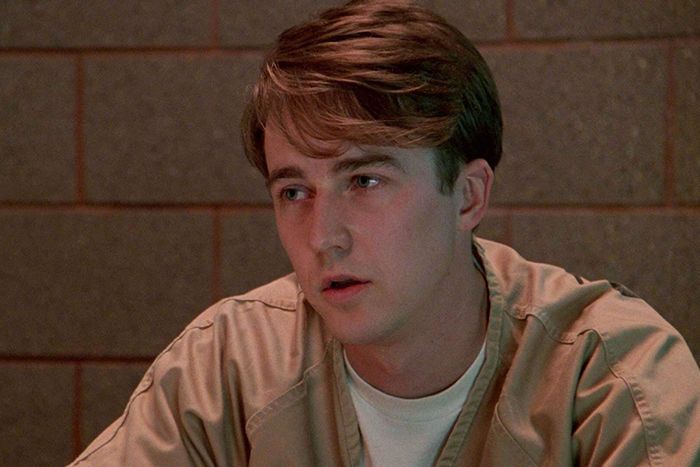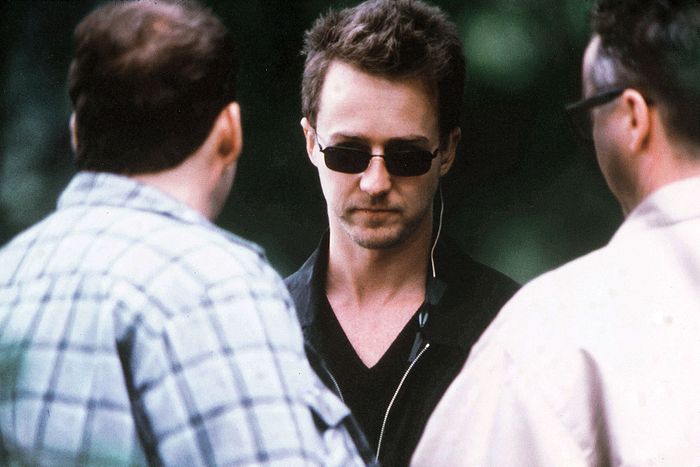
Some people make acting look easy, vanishing into roles in ways that render all decisions about timing and technique invisible. Edward Norton has never been one of them. To watch him is to be made aware of how difficult it can be, of how active the choices he’s making are — the tilt of a head, the narrowing of an eye, the tenor of a voice. He’s not one of those mysterious few anointed with the innately watchable quality we call movie stardom. In fact, the effort he puts into holding the screen feels born of a desire to counterbalance that, as though viewers would be in danger of drifting away were he not calling attention to the magic of performance.
You can practically feel the heat of the exertion he puts into playing Lionel Essrog, the 1950s private detective at the center of the long-awaited Motherless Brooklyn, which Norton also directed, produced, and adapted from the 1999 novel by Jonathan Lethem. As a character, Lionel owes something to noir archetypes, but the Tourette’s syndrome he grew up with adds an element of unpredictability to his every interaction. As a performance, he fits almost too neatly into Norton’s body of work, which is peppered with roles that speak more to physical precision than empathetic depth. It’s a type of performance Norton has returned to throughout his career — one that might be described as a virtuosic stunt, were it not for a callous tendency to treat actual impairment and plot gimmicks as one and the same, all fodder for Norton to display his talent. This practice has neither aged well nor proved to have a whole lot of staying power in popular memory.
Motherless Brooklyn is the first major contribution to Norton’s body of work in years, aside from voice acting and an uncredited (but memorably weird) cameo in Alita: Battle Angel. He picked up the rights to the book nearly two decades ago, just after he wrapped American History X and just before he was set to start shooting Fight Club. The era was, in retrospect, close to the apex of Norton’s standing in Hollywood — right between the film that earned him his second Academy Award nomination (his only one for Best Actor) and the one that would become his biggest cultural contribution. Vanity Fair crowned him “the finest actor of his generation,” he branded himself as someone interested in the work rather than the celebrity, and he managed to come out looking like the more reasonable party after the first of a few public squabbles for control over his work, this time with American History X director Tony Kaye, who had labeled Norton both a “narcissistic dilettante” and a “terrific actor.” (A similar conflict later resulted in Norton’s getting bounced from the MCU after 2008’s The Incredible Hulk for either being too difficult or too ambitious, depending on whom you ask.)
With the world at his feet, Norton zeroed in on a novel that was smart and acclaimed and that would also, courtesy of its protagonist’s neurological disorder, allow him to enact the kind of technical transformation at which he’d already proven himself so adept. It was how he’d leapfrogged from nowhere into a Best Supporting Actor Oscar nod for his debut in the 1996 courtroom thriller Primal Fear, in which he played high-profile murder suspect Aaron Stampler. Aaron has a stutter — Norton’s choice for the part; it was not written into the script — and a Kentucky accent, which the actor affected with such care that casting executives initially assumed it was his own. What really made the part juicy, though, was that the aw-shucks altar boy turns out to have a second personality, a swaggering, violent alter ego named Roy, who takes responsibility for the crime of which Aaron claims to have no knowledge. When Norton becomes Roy onscreen, the moment plays like an audition tape for the actor’s future fame, one the audience experiences alongside Richard Gere, who plays Roy’s hotshot defense attorney. Gere’s character even rewinds a recording of the transformation so we can appreciate the way Norton’s demeanor and posture change as he pops from one personality to the other.
Primal Fear hasn’t really stuck around in the cultural conversation, possibly because it’s exceedingly ridiculous, with its (spoilers!) sub–Keyser Söze–esque twist in which Aaron reveals that he’s been faking the dissociative identity disorder, the stammer, and the Boy Scout affect the whole time. When we rewatch the film now, what stands out is not so much the impressive, if insubstantial, flashiness of Norton’s debut but the revelation of how absurdly stacked the cast as a whole is. Gere is surrounded by the likes of Laura Linney, Alfre Woodard, Frances McDormand, and Andre Braugher grinding it out in more utilitarian roles as associates, exes, and courtroom fixtures. Faded from memory or not, the film feels as if it set the tenor for Norton’s career. For one thing, he went on to play increasingly stylized variations on the idea of split personalities, first as the nameless narrator of Fight Club, the disaffected Everyman to Brad Pitt’s ostentatious anarchist, then as the hapless Bruce Banner and his great, green, motion-captured alter ego in The Incredible Hulk.
Norton put his skill for delineating personas to use in other ways, too. He played a Brown philosophy professor and his pot-dealing identical twin in Tim Blake Nelson’s 2009 Leaves of Grass. In Frank Oz’s 2001 thriller The Score, he was Jack, a cocky young thief who goes undercover at the place he intends to rob, securing a janitorial job by pretending to be a man named Brian with a developmental disability. More than any other film Norton has done, The Score overtly presents him as an inheritor of a weighty tradition of Method actors, the young gun working with two legends of the field: He’s paired with Robert De Niro (with whom he’d work again in 2010’s Stone) as a seasoned safecracker looking for one last big job, while Marlon Brando, whom Norton has often cited as an inspiration, shows up in a smaller part as the fence who brings the two together. The assemblage plays better on paper than it does in practice, where it’s a surprisingly low-energy heist movie in which Norton seems to be trying to make up for his co-stars’ overall dolorousness.
But the truth is also that the scenes of Norton playing Brian are torturous — to watch him painstakingly twist his mouth and curl his hand to his chest in an approximation of palsy is to be reminded of that blunt joke about actorly vanity in Tropic Thunder. Brian is a plot construct, but he’s also an excuse to show off what Norton can do, with the built-in buffer of being a performance within a performance — it’s Jack, not Brian, doing this, but look how convincing the guy can be. Norton is far from the only actor in history to have looked at a disability and seen an artistic challenge. The way we think about who gets to play what kind of role is constantly changing, with the industry now reluctantly shifting its stance on performers treating sources of marginalization they don’t themselves experience as prime material. It’s not fair to expect work from 2001 to meet 2019 standards, but we can interrogate the compassion, or lack thereof, that accompanies this kind of acting exploit.
When it was published, the novel Motherless Brooklyn was set around 1999, and if Norton had put out his adaptation then, it might have faded seamlessly into the film landscape. In 2019, it’s a more awkward creation, marked by ideas and approaches that have accrued some dust. Norton made sweeping changes from the book, shifting the setting to the 1950s and expanding the scope of the mystery significantly. Today, Motherless Brooklyn is, ambitiously if not always deftly, about racial displacement and backroom power brokering overseen by a Robert Moses equivalent played by Alec Baldwin. Lionel’s Tourette’s syndrome is one of the few key elements Norton kept. He lovingly performs the motor tics, the involuntary exclamations, and the compulsive touching that becomes a punch line (“Sorry,” he says, as he repeatedly taps the character played by Gugu Mbatha-Raw on the shoulder, “Sorry”).
On the page, Lionel’s Tourette’s syndrome is an inextricable aspect of how he experiences the world and how thinks of himself; it’s inseparable from the freestyle dexterity with which his words spill out when he describes those experiences to the reader, who has the advantage of being in his head. But onscreen, Norton can’t figure out how to express that vivid sense of interiority beyond a voice-over, and it’s not clear whether he’s all that interested in doing so. In the movie, Lionel becomes someone who succeeds despite his Tourette’s syndrome, which is realized only as a set of external markers, with Norton also sanding away a lot of the weirder, more distinctive aspects of the character’s personality. Lionel hasn’t just been remade into a more traditional type of hero, he has also been afforded a tentative but definite degree of cool in his trim turtlenecks and his moodily lit apartment overlooking a bridge.
It’s enough to make you wonder whether Norton has grown weary of the kinds of ostentatious acts of mimesis for which he’s been known and whether they’re what he’s come to believe he has to do for audiences to be interested in seeing him save the day and get the girl. His retreat (or fade) from the spotlight in favor of tech investing has been treated as the natural outcome of a growing mutual disinterest; Hollywood has certainly been tilting away from the director-driven titles Norton has historically found most appealing. And whether because of his high standards or a need to maintain control, Norton hasn’t established himself as someone who always plays well with others. That said, there’s still room for someone like Adam Driver, a kind of successor to Norton in the types of roles he takes, his aura of actorly seriousness, and his general caginess about the press. (Driver was even recently on Broadway playing the role in Burn This that Norton won an Obie for in 2003.) Meanwhile, for Norton to play the kind of part he wants now, he had to push through a passion project he’s been trying to make for 20 years, only to find less enthusiasm for the result than he surely had hoped for, in both its mixed critical reception and its underwhelming box office.
Motherless Brooklyn isn’t Norton’s directorial debut. (It’s not his best performance, either: That would be his incendiary turn in Spike Lee’s 25th Hour, in which his skill at switching personas gets dialed down to suit a character who can’t settle on the false front he wants to present to the world.) It’s easy to forget that the first time Norton went behind the camera was back in 2000 for Keeping the Faith, a pleasantly low-key affair with a premise that read like a “walks into a bar” joke. Norton played a priest, Ben Stiller a rabbi, and Jenna Elfman the childhood friend for whom the men each develop feelings with various religion-related complications ensuing.
The only shock of this movie was that Norton, already consigned to a brand of self-seriousness, had wanted to make something as straightforwardly pleasurable as a romantic comedy. He wouldn’t go on to play roles like the one he does in Keeping the Faith much after that. But it’s fun to imagine an alternate universe in which he did — a world where he got out from under the stifling weight of the type of work for which he has become known. Everyone deserves moments of making things look easy.







